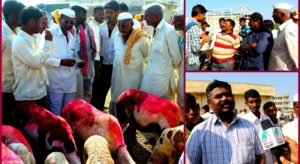By Nilay Wankhade
On Wednesday mornings, I wake up before the alarm rings. It’s the day weekly market is organised in Mhaswad (which has been my home for the past ten months, ever since I joined a grassroots social leadership program called India Fellow). As my accommodation is pretty close to the local animal market, the bellows and bleats of the animals are loud enough to work as an alarm. But, on November 9 2016, the scene was unusual. Instead of the animal sounds, the noise of people quarrelling and arguing was louder. A night earlier, the central government had announced a demonetisation policy, banning currency notes worth 500 and 1000 Indian rupee. I regularly visit this weekly animal market to collect import and export statistics on the current highs and lows in the market; which is later aired on the radio.

I work with a community radio and was equipped with recording instruments, but this time I visited the market with a different purpose. It was to see how the market proceeds and record opinions of the farmers and dealers on demonetisation. To my surprise, some parts of the market were unaware of the government’s decision and people were accepting demonetised currency without any hesitation. While other parts of the market were confused whether to accept high-value currency or not. The market committee staff was also incapable to guide the farmers, as they were waiting for instructions from higher authorities.
The number of transactions in the market went down by almost half. Many of the farmers and dealers waited for some time and left the market without engaging in any transactions and were looking forward to next Wednesday. Some farmers sold their cattle due to financial urgencies and had to do business at a lower price and against their will. That morning brought forth, a completely unexpected scenario.
The condition was pretty much the same at the vegetables and grocery market too. People were confused as they held their high-value currency notes, trying to make arrangements for that week’s supplies. By the end of the day, I was able to record the opinions of more than a dozen people. There were a few, who were completely against this decision whereas the majority looked at it positively. Some villagers also believed that the decision will seize the black money within the country which will lead to nation’s prosperity. Despite this harsh and swift decision, the majority of the people were patient and ready to face discomfort to a certain extent, if the promised outcomes of the decision are achieved.
Editor’s Note:
The Government of India announced a demonetization policy on the 8th of November 2016, immediately banning currency notes worth 500 and 1000 Indian rupee. The government announced this as a measure to curb black money circulation.
Mhaswad is a block in the Satara district of Maharashtra.
About the Author:
Nilay Wankhade is an Ideosync UNESCO India fellow 2016-17 batch placed with Manndeshi Tarang Vahini, a community radio station in Mhaswad, Maharashtra as part of his fellowship. He is working on strengthening the community radio and making it a more vibrant space.
The blog was originally published on India Fellow.
